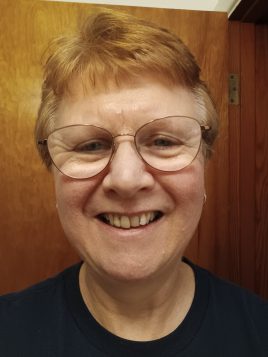 For people living with chronic pain, the experience can be overwhelming, leading to depression, anxiety, and an inability to carry out daily tasks. Fran Haselhoff, who has lived with constant abdominal pain for more than eight years, found help — and an improved quality of life — at UPMC Pain Management through an integrative approach involving physical and behavioral health treatments.
For people living with chronic pain, the experience can be overwhelming, leading to depression, anxiety, and an inability to carry out daily tasks. Fran Haselhoff, who has lived with constant abdominal pain for more than eight years, found help — and an improved quality of life — at UPMC Pain Management through an integrative approach involving physical and behavioral health treatments.
A Constant Pain
“A huge, red-hot screwdriver sticking straight out of my abdomen” is how Fran describes the severe and persistent pain she has lived with since 2015. “It’s 24 hours of nonstop pain,” she says.
Fran’s pain eventually was diagnosed as nerve entrapment, or compressed nerves, due to multiple abdominal surgeries over two decades. Each surgery — two Cesarean sections, plus a hysterectomy and follow-up surgery to remove additional endometrial tissue — involved a vertical incision through the same scar.
“At first, it was a dull ache that became piercing at times. But it was constant and gradually got worse,” says Fran, 62, a White Oak, Pa., resident.
Never Miss a Beat!
Subscribe to Our HealthBeat Newsletter!
Thank you for subscribing!
You can now select the specific newsletters you'd like to receive.
You are already subscribed.
Subscribe to more newsletters in our email preference center.
Sorry, an error occurred. Please try again later.
Get Healthy Tips Sent to Your Phone!
Searching for Relief
Before she developed the pain, Fran led an active life. She worked a physical, full-time job at a machine embroidery shop. She also walked three miles a day and swam at least twice a week.
The pain started in early 2015. Over the next seven months, Fran saw 16 specialists and underwent various treatments — including exploratory surgery — but found no relief from her symptoms. As her pain progressed, she stopped exercising. She found herself unable to stand for long periods of time and even sitting became difficult. Unable to sit upright in a regular chair, Fran started taking her own special chair to appointments. Her lightweight antigravity reclining chair is designed to distribute weight evenly to relieve pressure and improve circulation.
“By the end of July, I couldn’t work because I couldn’t sit in the car for the 30 minutes it took to get there,” says Fran. “I brought paperwork home, but I couldn’t even do that, so I had to quit.”
A Multimodal Approach
Finally, Fran was referred to Trent Emerick, MD, MBA, a UPMC pain management specialist who is board-certified in anesthesiology, pain medicine, and addiction medicine.
Dr. Emerick uses a comprehensive approach that focuses on reducing pain, enhancing function, and improving quality of life for patients. He started Fran on a course of treatments that involved medicine, injection therapies, and occupational and physical therapy. Dr. Emerick also referred her to a neurosurgeon for a neurostimulator implant — a small device like a pacemaker that uses electrical impulses to disrupt pain signals to the brain.
Although the neurostimulator took the edge off her pain and occupational and physical therapy helped, most of the treatments had little impact.
During one follow-up appointment with Dr. Emerick, Fran admitted her frustration, telling him, “I’m crying every day. My entire life has been reduced to my house.”
Recognizing that pain wasn’t the only issue that needed to be addressed, Dr. Emerick referred Fran to UPMC pain psychologist Susan E. Jarquin, PhD, MBA, a member of the behavioral management team at UPMC Pain Management.
Quieting the Mind
Fran was at a low point when she began seeing Dr. Jarquin in early 2016. “Emotionally and mentally, I was very down. I was very depressed,” says Fran. “I didn’t want to wake up in the morning because the first thing I felt was pain. I really needed help dealing with it.”
Dr. Jarquin is a recognized expert in behavioral medicine interventions and multidisciplinary pain treatment. Her approach focuses on how people respond to pain and encourages patients to develop coping strategies to manage their symptoms. She worked with Fran to identify her emotional triggers and taught her how to use mindfulness, relaxation, and other coping skills to quiet her mind and manage her pain.
The effect on Fran was profound. “Dr. Jarquin taught me pretty quickly about the ‘gateway of pain’ — how your emotions make the gate stay open to allow more pain signals through,” she says.
“That’s the good thing about a psychologist who deals in pain — she knew what I was going through. She knew the pain was real and she empowered me by giving me tools to deal with the pain.”
With Dr. Jarquin’s guidance, Fran learned to use:
- Relaxation through breathing and mindful meditation to regulate her thoughts so she could concentrate on her activities instead of the pain.
- Pacing techniques to spread out activities so she can still do meaningful things, such as spending time with family or cooking.
- Rethinking and cognitive diffusion skills to manage anxious and depressed thoughts about pain and pain interference.
“These are tools I’m still using seven years later,” says Fran. “She taught me how to breathe and relax to let things calm down. She showed me how to pick and choose what I can and want to do. She introduced me to meditation to calm my mind and mindfulness to distract myself from the pain.”
A Better Quality of Life
Fran still sees both doctors for ongoing care. Dr. Jarquin continues to introduce new tools and activities. When she suggested Fran use her brain to learn something new, Fran started taking Spanish lessons. She also urged Fran to join a support group coordinated through the American Chronic Pain Association. Fran is now very involved with the group and even serves as a substitute leader.
“The support group has been very helpful. None of us has the same pain, but it makes a big difference talking to people who understand what you’re going through,” says Fran. “Being involved also gives me a purpose — like I’m doing something worthwhile.”
Fran credits both Dr. Jarquin and Dr. Emerick with helping her to achieve a better quality of life. Although she still lives with pain, she is able to manage symptoms so she can take part in activities of interest and spend time with family, including playing games and doing crafts with her grandchildren. “They gave me the ability to stretch my limits,” says Fran.
“I can’t imagine where I’d be without Dr. Jarquin or Dr. Emerick,” Fran adds. “Mentally and emotionally my quality of life is much better now. I rarely cry anymore. The pain is still there — I can’t ignore it — but I can do more because I don’t lend it as much time. It has made a huge difference in my life.”
To learn more about behavioral medicine treatment for chronic pain, call 412-665-8030 or visit UPMC.com/PainManagement.
Fran’s results may not be representative of all similar cases. Treatment options discussed in this patient story may not be covered by insurance. Consult your insurance plan regarding your coverage.
Editor's Note: This article was originally published on , and was last reviewed on .
About UPMC
Headquartered in Pittsburgh, UPMC is a world-renowned health care provider and insurer. We operate 40 hospitals and 800 doctors’ offices and outpatient centers, with locations throughout Pennsylvania, Maryland, New York, West Virginia, and internationally. We employ 4,900 physicians, and we are leaders in clinical care, groundbreaking research, and treatment breakthroughs. U.S. News & World Report consistently ranks UPMC Presbyterian Shadyside as one of the nation’s best hospitals in many specialties and ranks UPMC Children’s Hospital of Pittsburgh on its Honor Roll of America’s Best Children’s Hospitals. We are dedicated to providing Life Changing Medicine to our communities.

